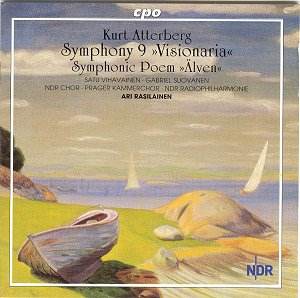This concludes CPO’s set of the nine numbered
symphonies. The choral Ninth dates from 1956 and is a tough, dark,
often unyielding work. Taking as its text a selection from Volupsá
(The Face of the Prophetess), saga stories steeped in apocalyptic
fatality, Atterberg’s frequently grim introspection also embraces
cataclysm and stasis as well as seriousness and moments of lyric
ardour. Written for baritone and alto soloists – with one duet
– the aesthetic is at times almost remorselessly internalised
but generates a powerful sense of symphonic inevitability. After
the section, an Introduction, marked Beginning there is some expressive
material for the alto before a hieratic, Wagnerian passage for
baritone soloist intrudes but in Väl vet hon we can
hear an almost "speaking" legato, a sense of consolidated,
concentrated power and seriousness which comes before more determined
sectional brass writing, chugging strings and wind, whooping horns
and warlike percussion. His orchestration is relatively sombre
for all these occasional outbursts; a just medium through which
to express feelings both bleak and fearful. The duet between the
soloists acts as a kind of Adagio section with its own saga-harp
interjections and it’s the mezzo soloist who bears the weight
of the increasing pessimism of Mycket jag fattat with its
trumpet and drum powered determination and implacable choral part.
But after the strife and the occasional bludgeoning comes a passage
for solo violin and harp and the baritone’s consoling vision even
though the mezzo, Satu Vihavainen still retains a punishing edge
to her tone and is accompanied by sometimes uneasy orchestral
forces. This is a symphony that can never afford to let down its
guard. Its consolation is accompanied by constant evaluation;
it’s a dark, searing work, complex and forbidding.
All the more apt I suppose that it should be
partnered by Älven – The River – a bright, colourful, wonderfully
warm symphonic poem. This is the Atterberg that most will recognise
– bright primaries, perky, chattering winds, insistent percussion,
wonderful drama and drive and orchestral confidence. Listen to
the lazy shimmer of the Great Lake or the impulsive horns that
announce the Waterfalls as they conjoin with high winds in a long,
big-boned sense of animation and surge. Atterberg seems effortlessly
to summon up expanse and vista and glittering light seen from
afar – and spices things up in the modernistic harbour scene;
all raucous tone painting, horn whoops and Nauticalia. And when
Atterberg leads us Out to The Sea there is real nobility and grandeur.
The ship’s engines are hinted at through the drums as we drive
forward, strings lapping their way around the glorious melody.
The performances are in the main unimpeachable,
though there were some brief moments of questionable choral unison
passages. The works are almost rudely contrastive but constructively
so.
Jonathan Woolf
see also review by
Rob Barnett
